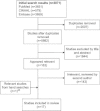Transitional care programs: who is left behind? A systematic review
- PMID: 23593046
- PMCID: PMC3601531
- DOI: 10.5334/ijic.805
Transitional care programs: who is left behind? A systematic review
Abstract
Objective: Older adults are at risk of rehospitalization if their care transitions from hospital-to-home are not properly managed. The objective of this review was to determine if older patient populations recruited for randomized controlled trials of transitional care interventions represented those at greatest risk of rehospitalization following discharge. Relevant risk factors examined were cognitive impairment, depression, polypharmacy, comorbidity, length of stay, advanced non-malignant diseases, and available social support.
Design: Systematic review.
Setting: Hospital to home.
Participants: Older hospitalized adults.
Measurements: For inclusion, articles were required to focus on hospital-to-home transitions with a self-care component, have components occurring both before and after discharge, and a randomized controlled trial design. Articles were excluded if participants had a mean age under 55 years, or if interventions focused on developmental disabilities, youth, addictions, or case management, or were solely primary-care based.
Results: Following title, abstract, and full review by two authors, 17 articles met inclusion criteria. Risk factors for rehospitalization were often listed either as exclusion criteria or were not reported at baseline by the studies. One study included patients with all identified risk factors for rehospitalization.
Conclusions: These data suggest that published studies of transitional care interventions do not often include older adults at highest risk of rehospitalization, raising concerns about the generalizability of their results. Studies are needed that evaluate interventions that explicitly address the needs and characteristics of these patients.
Keywords: care transitions; comorbidity; rehospitalization; self-care; systematic review.
Figures
Similar articles
-
The impact of transitional care programs on health services utilization in community-dwelling older adults: a systematic review.JBI Database System Rev Implement Rep. 2018 Feb;16(2):345-384. doi: 10.11124/JBISRIR-2017-003486. JBI Database System Rev Implement Rep. 2018. PMID: 29419621
-
Beyond the black stump: rapid reviews of health research issues affecting regional, rural and remote Australia.Med J Aust. 2020 Dec;213 Suppl 11:S3-S32.e1. doi: 10.5694/mja2.50881. Med J Aust. 2020. PMID: 33314144
-
Association between pacifier use and breast-feeding, sudden infant death syndrome, infection and dental malocclusion.JBI Libr Syst Rev. 2005;3(6):1-33. doi: 10.11124/01938924-200503060-00001. JBI Libr Syst Rev. 2005. PMID: 27819973
-
The Effectiveness of Integrated Care Pathways for Adults and Children in Health Care Settings: A Systematic Review.JBI Libr Syst Rev. 2009;7(3):80-129. doi: 10.11124/01938924-200907030-00001. JBI Libr Syst Rev. 2009. PMID: 27820426
-
The Use of Transitional Care Models in Patients With Stroke.J Neurosci Nurs. 2015 Aug;47(4):223-34. doi: 10.1097/JNN.0000000000000143. J Neurosci Nurs. 2015. PMID: 25906245 Review.
Cited by
-
A novel approach to medicines optimisation post-discharge from hospital: pharmacist-led medicines optimisation clinic.Int J Clin Pharm. 2020 Aug;42(4):1036-1049. doi: 10.1007/s11096-020-01059-4. Epub 2020 Jun 11. Int J Clin Pharm. 2020. PMID: 32524511 Free PMC article. Clinical Trial.
-
Effectiveness of the Sub-Acute Care for Frail Elderly (SAFE) Transitional Care Unit on Short-Term Functional Independence in Frail Older Patients Discharged from Hospital.Can Geriatr J. 2024 Dec 1;27(4):418-429. doi: 10.5770/cgj.27.721. eCollection 2024 Dec. Can Geriatr J. 2024. PMID: 39619381 Free PMC article.
-
Health care transitions for persons living with dementia and their caregivers.BMC Geriatr. 2021 Apr 29;21(1):285. doi: 10.1186/s12877-021-02235-5. BMC Geriatr. 2021. PMID: 33926380 Free PMC article.
-
Challenges to Admitting Residents: Perspectives from Rural Nursing Home Administrators and Staff.Inquiry. 2021 Jan-Dec;58:469580211005191. doi: 10.1177/00469580211005191. Inquiry. 2021. PMID: 33769114 Free PMC article.
-
Lost in transition? Community residential facility staff and stakeholder perspectives on previously incarcerated older adults' transitions into long-term care.BMC Geriatr. 2023 Mar 28;23(1):180. doi: 10.1186/s12877-023-03807-3. BMC Geriatr. 2023. PMID: 36978019 Free PMC article.
References
-
- Bernstein AB, Hing E, Moss AJ, Allen KF, Siller AB, Tiggle RB. Health care in America: trends in utilization. Hyattsville, Maryland: National Center for Health Statistics; 2003.
-
- Naylor MD, Brooten DA, Campbell RL, Maislen G, McCauley KM. Transitional care of older adults hospitalized with heart failure: a randomized, controlled trial. Journal of the American Geriatrics Society. 2004;52:675–84. - PubMed
-
- Coleman EA, Smith JD, Frank JC, Min SJ, Parry C, Kramer AM. Preparing patients and caregivers to participate in care delivered across settings: the care transitions intervention. Journal of the American Geriatrics Society. 2004;52:1817–25. - PubMed
-
- McCauley KM, Bixby MB, Naylor MD. Advanced practice nurse strategies to improve outcomes and reduce cost in elders with heart failure. Disease Management. 2006;9(5):302–10. - PubMed
-
- Naylor MD, Brooten DA, Campbell RL, Jacobsen BS, Mezey MD, Pauly MV, et al. Comprehensive discharge planning and home follow-up of hospitalized elders: a randomized clinical trial. The Journal of the American Medical Association. 1999;281(7):613–20. - PubMed
LinkOut - more resources
Full Text Sources
Miscellaneous


